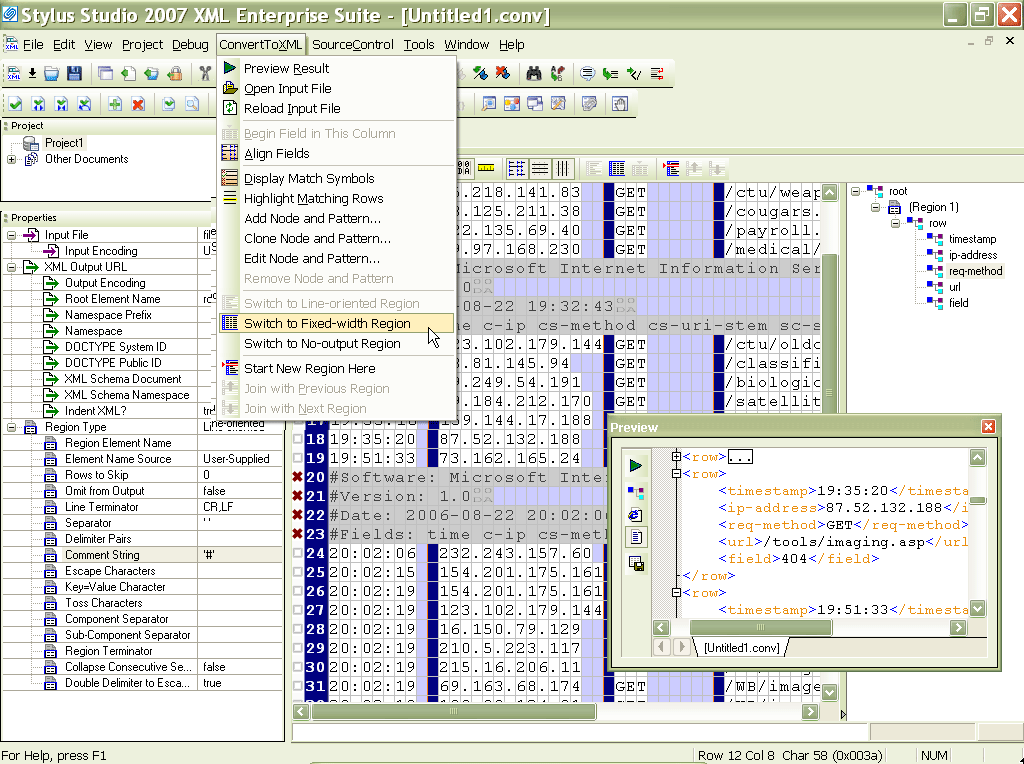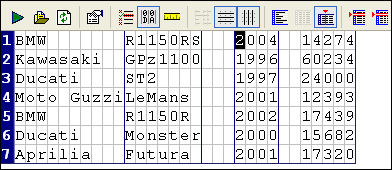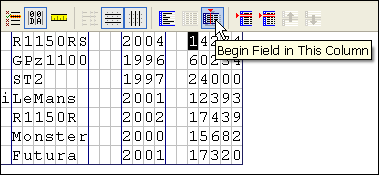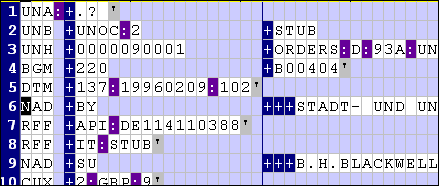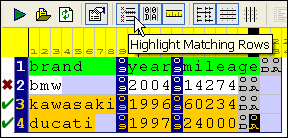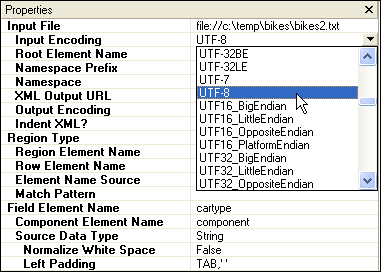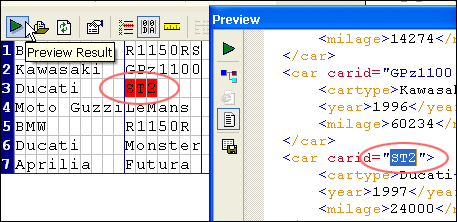|
Home > XML IDE - XML Editor > XML Editor Key Features > Import Export XML > Convert to XML
Import Export XML
Convert to XML
XML Pipeline Server™ is the highly scalable server platform that automates data conversion, validation, transformations, report and document generation from/to a variety of data sources. Deploy XML Pipeline Server™ on any server or workstation in your enterprise. You can also have a zero footprint deployment using our cloud-based offering. Use Stylus Studio to Convert to XMLStylus Studio's Convert to XML is a powerful visual tool for defining custom XML converters for use in legacy data integration (Illustrated below, click to enlarge). If you need to get flat files, EDIFACT, IATA, X12, EANCOM into an XML format for use in a Java or Microsoft .NET application, then you can use the hundreds of built-in XML converters that are included in DataDirect XML Converters™. Otherwise, Convert to XML allows you to design custom XML converters to get any non-XML files (for example, proprietary file formats) into an XML document format. Convert to XML works with Stylus Studio®'s XML data source framework, enabling you to treat any legacy data file as a live XML data source for use elsewhere in Stylus Studio® — for example, as an input source for an XQuery or XSLT mapping project. The easiest way to learn how to use Convert to XML is to watch a two-minute, free online video demonstration of an example Convert to XML application, available from the videos section of the website. Please note that Convert to XML is only available in Stylus Studio® XML Enterprise Suite. Support for Any Legacy File Format or EncodingConvert to XML works on any legacy data input file, for example, text files, comma separated values (CSV), tab separated values, binary data, EDI, ASCII files, or any other flat file format. Stylus Studio® can also read dozens of different file encodings, understand various data types, and so on.
Visually Specify Field DelimitersConvert to XML makes it easy to visually inspect files and insert field delimiters exactly where each data field begins and ends. Only Convert to XML supports the concept of 'fixed width regions' which allows you to specify different field delimiters for different sections of a file. The following illustration demonstrates visually specifying a data field delimiter using Convert to XML.
EDI to XML Mapping SupportConvert to XML can read header records of popular EDI formats such as HL7, UN/EDIFACT, X12, IATA and EANCOM, enabling advanced EDI to XML legacy data integration solutions. The following illustration shows an EDI file loaded into Convert to XML. See Converting EDI to XML to see how this is done with a sample document.
Stylus Studio® also comes with native adapters for bi-directional mapping directly from EDIFACT, EANCOM, IATA and X12 to XML and back, and support for validating EDIFACT data against the equivalent XML Schemas. A valuable and free reference site for understanding EDIFACT messages, segments, elements and code lists is available as the EDIFACT Zone. Advanced Data Filtering OptionsConvert to XML provides a wealth of advanced data filtering to remove unwanted data from your target XML output file. Convert to XML supports the use of regular expressions for pattern matching on specific data fields and other field matching options. The following screenshot displays the results of a filter that only displays cars from before the year 2000.
Advanced Convert to XML PropertiesConvert to XML allows complete customization of any flat file to XML data conversion, allowing you to specify from dozens of properties including Input encoding, namespace and namespace prefix, output file name, indentation, element or attribute name, white space normalization, field padding, offsets, and more. Some of the Convert to XML property settings are illustrated below:
Integrated Convert to XML Preview Window with BackMappingAn integrated XML Conversion Output Preview Window allows you to pre-view the output of a Convert to XML operation and view the results in any of Stylus Studio's XML editing views, for example, HTML (Browser) View, Text View, or Tree View. It also has buttons to refresh the output, save the XML output to a file, and more! Additionally, the XML Conversion Output Preview Window supports backmapping, allowing you to click anywhere on the output file to visually locate either the source of a particular XML node, thus providing valuable feedback to help in troubleshooting advanced legacy data to XML conversion. The following screenshot illustrates the backmapping concept — highlighting a 'carid' attribute in the output causes Stylus Studio® to highlight the corresponding source in the flat file source pane.
Other Advanced XML Data Integration and Usability FeaturesConvert to XML understand numerous common data types, allowing you to easily normalize your input data files. Additionally for numbers, Convert to XML understands many currency formats, different bases, and much more! Complete support for Undo and Redo further enhance usability. Generate Java Code to Call XSLT or XQuery, or Call APIs DirectlyNow that you've gotten your transformation to work once, save the converter definition and compile it for use in your Java or .NET programs with DataDirect XML Converters™, (scalable Java and .NET components for streaming non-XML data to and from your program code) — Java Code Generator (video demo). This will combine any of the Java-based XSLT or XQuery engines, including DataDirect XQuery, that support custom URI resolvers with the adapter logic to make a component you can use outside of the Stylus Studio® environment. For the handyman, you can do it yourself — the steps are simple, and the article XML Adapters Unleashed shows you how. You can go even further, to the simple and direct Data Conversion APIs, which are designed for direct embedded in your application and chaining between XML consumers and XML producers. Generate Java Code for XML PipelinesOften integration requires more than a single conversion — there may be steps requiring merging, splitting, publishing, copying, validating, storing and whatnot. The XML Pipeline module includes a user-interface for graphically connecting together the pieces, and a cute little button that packs quite a whallop — it will generate all of the code necessary to run the conversions, transforms, or whatever you've specified. Convert to XML is the most powerful utility for converting any data source — flat files, binary data, EDI, and any other format — into XML, enabling advanced XML-based legacy data integration solutions Try it out today for free! |
PURCHASE STYLUS STUDIO ONLINE TODAY!!Purchasing Stylus Studio from our online shop is Easy, Secure and Value Priced! Try Convert to XML!Download a free trial of Convert to XML, the industry-leading legacy data integration utility today! What's New for Stylus Studio® X16?New XQuery & Web Services Tools, Support for MySQL, PostgreSQL, HL7 EDI, Microsoft .NET Code Generation and much more! Ask Someone You KnowDoes your company use Stylus Studio? Do your competitors? Engineers from over 100,000 leading companies use Stylus Studio, and now you can ask someone from your own organization about their experiences using Stylus Studio. Support XQuery in the Microsoft .NET Framework10 Simple things you can do to help support XQuery in the Microsoft .NET 2.0 Framework - Read on! |
XML PRODUCTIVITY THROUGH INNOVATION ™

 Cart
Cart


